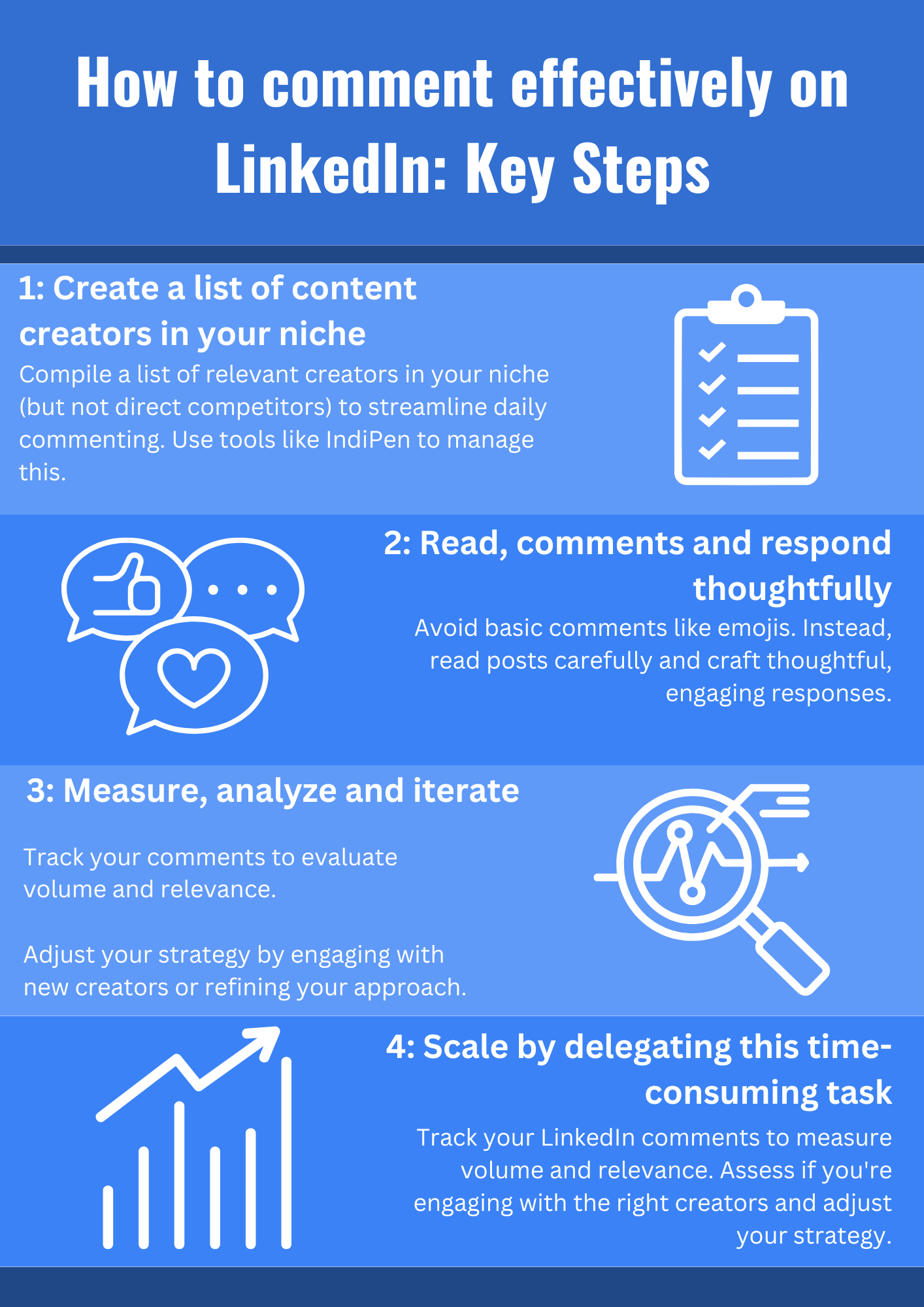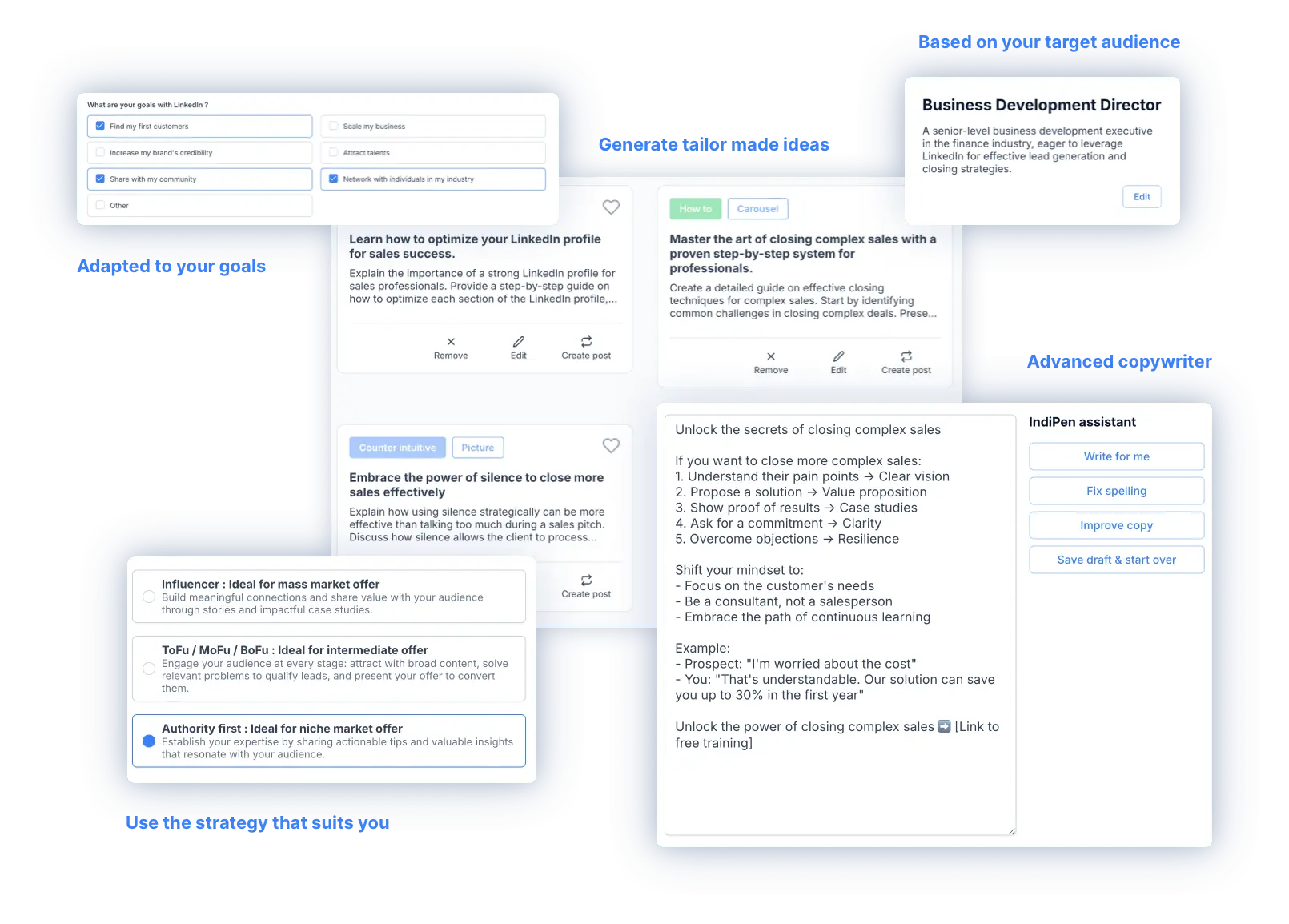Commenting on LinkedIn posts from content creators: an effective strategy to boost your visibility and attract leads
Are you looking to attract more leads on LinkedIn?
Commenting on LinkedIn posts from other creators is often underestimated, but it can be a real growth lever, not only for your audience but also for generating direct leads.
In this article, we will explore the benefits of commenting regularly and how to do it effectively to optimize your overall LinkedIn strategy for lead generation.
Why comment on LinkedIn posts from content creators?
If you want to get results on LinkedIn by only posting, you’ll quickly hit a limit. This is why commenting can boost your visibility for several reasons.
So, let’s comment on posts by potential prospects, other people in our industry, and thought leaders/top creators in our niche.
Commenting will help you be seen countless times in the news feed, among other benefits. Here are some great reasons to comment:
Increase visibility by being omnipresent in the news feed of prospects
Posting once a day ensures you’ll be seen this way, but if you add a multitude of relevant comments, you’ll appear constantly in the news feed of your prospects.
The more relevant your comments are, the more likely you are to generate leads.
You’ll be seen by your current connections as well as by others who are not yet connected to you, and there’s a good chance they’ll add you as a connection.
For a beginner content creator, you may even get more visibility through commenting than through your own posts.
Don’t forget that every time your name appears, it also includes your profile title, and if this value proposition is well optimized, you’ll attract attention and even interact with prospects.
Build an audience from the audience of other creators
Instead of starting completely from scratch, why not think that your prospects, your target audience, are already consuming content from other creators in a similar niche?
Let’s say you’re an SEO consultant for startups. If you regularly comment on posts from other creators who bring value to startups about customer acquisition, you’ll be able to tap into a qualified audience from another creator. In a sense, you’ll share this audience.
You can therefore share audiences by writing relevant comments on others’ posts.
Commenting is an opportunity to show your expertise and gain the trust of an audience
A creator will talk about a topic, and if you see an anecdote, another viewpoint, or something to add, if done well, it’s the perfect opportunity to showcase your expertise, attract a new audience, and even strengthen your image as an expert in your niche.
Have you ever seen an interesting post and found yourself equally curious by checking out the top comment to see people’s opinions on the subject? Sometimes, you might even agree more with the comment than with the post itself. That’s exactly what we’re aiming to do – emotionally connect with readers.
Support other creators, and some will support you in return
You can go faster alone, but you’ll go further together.
Every creator loves receiving engagement on their posts, likes, comments, etc. It helps them gain visibility and more. They’ll see the value in this. By commenting on other creators’ posts, you’ll help them grow.
So, by helping them, there’s a good chance that some will reciprocate and comment on your posts too.
The more interactions you get on your posts, the more likely you are to be seen and gain prospects.
Some big creators, like Lara Acosta, recommend doing up to 200 comments per week.
Commenting to boost the LinkedIn algorithm
It’s difficult to know exactly what’s behind an algorithm, but if we look at the business model of a social network, it wants users to spend as much time on the platform as possible, to create a habit and monetize their attention. Based on this principle, spending time commenting aligns you with LinkedIn’s interests, as it promotes social interactions.
Additionally, many LinkedIn experts with large audiences recommend commenting regularly, and they practice this strategy themselves.
How to comment effectively on LinkedIn: Key Steps

Step 1: Create a list of content creators in your niche
You’ll need to do this every day, so it’s best to be efficient and list the most relevant content creators in your niche. Avoid direct competitors, but other people in your niche will often be a great choice.
Then, list them in an Excel file or a tool dedicated to growing your LinkedIn audience, like IndiPen.
Step 2: Read comments and respond thoughtfully
Leaving very basic comments like emojis or short texts will give you minimal results.
A successful comment is often more thought-out. Take the time to read the post and find the angle you’ll use to write your comment.
Step 3: Measure, analyze, and iterate for effective comments
On your LinkedIn profile, you can track your comments, measure the volume of your comments, and analyze their relevance. You can assess if you’ve focused your time on engaging with the right content creators.
It might be the right moment to change the creators you’re commenting on, increase the volume, or change your commenting style. In short, iterate your LinkedIn comment strategy.
Step 4: Scale your LinkedIn comments by delegating this time-consuming task
As your presence on the platform and your business grow, this task can easily be delegated. The biggest LinkedIn accounts often have entire teams helping them maximize their LinkedIn actions. Surround yourself with support as your business grows.
Mistakes to avoid in your LinkedIn comments
Generic comments
Example: “Very interesting!” or ”🔥🔥” without adding anything else.
Negative criticism without arguments
Be constructive. You can disagree while being respectful.
Ignoring replies to comments
Engagement doesn’t stop at the first comment – follow the conversation.
Talking too much about yourself
Try to highlight the creator instead of yourself.
Self-promotion
Pushing your offers without a clear reason… yes, some people do that 😅
Examples of good LinkedIn comments
Sometimes, you can even create a “ratio” comment, where your comment gets more interactions than the post itself.
Here are some examples of relevant LinkedIn comments:
Example 1: Expanding on an Idea
“I love your point on the importance of consistency. I’ve also noticed that planning your posts ahead of time really helps!”
Example 2: Asking a relevant question
“Thanks for sharing! What do you think about tools like IndiPen to improve your content strategy?”
Example 3: The antagonistic approach
“I think you’re wrong on this topic because of A, B, C, etc.”
Example 4: Showing support
“I’ve been following you for a while, and I don’t usually comment, but what you’ve accomplished is truly inspiring. You did A, then B, while staying humble. Congratulations again on all your achievements.”
Example 5: A joke
Adding a meme or a situational joke.
Ready to turn your LinkedIn profile into a Lead Machine ?
IndiPen helps you define your strategy, find content idea and write engaging content to generate leads with ease
Book a demo
